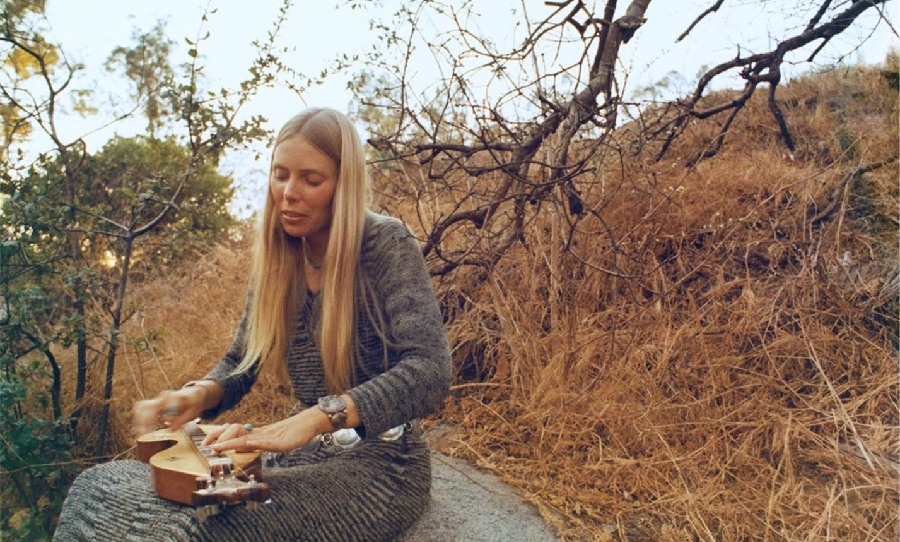Joni Mitchell’s Blue is a timeless masterpiece. Its songs arose from dealing with fame, and the sensations associated with grief and new beginnings.
In 1970, as Joni Mitchell was dealing with newfound fame, the end of her relationship with Graham Nash, and the start of a new romance with James Taylor. She wrote the songs that would become Blue straight from the heart, writing and producing the entire album herself.
Blue is as simple in its musical production as it is in exposed lyrical content. Joni Mitchell’s decision to use less than 10 instruments across the album left nowhere to hide inside this profound statement of truth. It’s the most intimate and honest work of her extensive career.
The lonely painter
Joni Mitchell grew up in Fort Macleod, Alberta, Canada and her family moved around until settling in Saskatoon, which she refers to as her hometown. Growing up, Mitchell’s main interest was painting but took an interest in music with classical piano, guitar, ukulele, and songwriting. After contracting polio — which left her hospitalised for weeks — she began experimenting with alternative tunings to accommodate a weaker left hand. These alternative tunings would shape her individual musical choices throughout her career.
Still passionate about art, Mitchell studied at the Alberta College of Art and performed her music at folk clubs around Calgary. And as a penniless art student, she fell pregnant. Knowing the consequences of keeping her child, she decided to give her child away for adoption. Whilst performing around Canada she met Scott ‘Chuck’ Mitchell, to whom she confided that she needed work. He said he could get Joni to work in the United States.
As a solution to an immigration problem, the two of them married, as Joni Mitchell says in the documentary Joni Mitchell: Woman of Heart and Mind: “for all the wrong reasons“. And in respect to walking down the aisle, her only thoughts were, “I can get out of this”.

The Mitchells performed together, but it was not a good fit musically, and Joni felt trapped by Chuck’s controlling of the money and performances. They divorced in 1967 and Joni moved to New York City.
Joni Mitchell’s artistry always impressed the music community as people like David Geffen, Elliot Roberts, and David Crosby created opportunities for Mitchell and her folk music. 1968 saw the debut release Song To A Seagull with David Crosby as a producer. It’s a solo acoustic album with none of the folk-rock overdubs which were in vogue at the time. The album had moderate success, but more importantly, people were watching her.
Joni Mitchell’s subsequent release Clouds may very well have been the nucleus for her career path, as she produced all but one song on the album and painted the cover art. Clouds won a Grammy for Best Folk Performance and climbed to number 22 on the Canadian charts and number 31 on the US Billboard charts, featuring the songs Chelsea Morning and Both Sides, Now.
Lady in the canyon of fame
As Joni Mitchell was growing as an artist, refining her songwriting and her musical style, she released her third studio album Ladies of The Canyon. Produced entirely by Mitchell — with more musicians, overdubs, and a more sophisticated sound leaning towards pop and rock production — this album hosted three of her most notable songs (Big Yellow Taxi, The Circle Game, Woodstock) which FM radio briskly took to, resulting in her first Gold record.
This album was an upward progression commercially for Joni Mitchell, and put her in the spotlight both musically and in the press, as it was in the top 20 in Canada and the UK and the top 50 in Australia and the US.
The biggest single in Mitchell’s career so far, Big Yellow Taxi, was released in 1970. This pop protest song reached number six on the charts in Australia, number 11 in the UK, and number 14 in her home country of Canada — the song has also been covered and released as a single many times since.
Mitchell found it hard to deal with this newfound fame — she felt she was being put up on an unstable pedestal — so she decided to take a year off touring and paint. It was in this reflective time period she was able to have the mental space to write the honest, truth baring songs to be featured on Blue.
To quote Mitchell from the documentary Joni Mitchell: Woman of Heart and Mind: “I felt uncomfortable with the attention of fame, and almost felt like I had to be honest to my audience so they knew who I was.”
The time off for painting turned itself into a European trip, finding herself in Greece to pen some of the songs for Blue and make the decision to end her time with Graham Nash, as she would telegram him saying, “If you hold sand too tightly, it will run through your fingers”.
Painting the colour blue
1971 saw many women release influential albums. From Janis Joplin to Bonnie Raitt, Carly Simon to Carole King with her iconic Tapestry (on which Mitchell sang backing vocals). Other releases in the same year were Elton John’s Madman Across The Water, The Doors’ L.A. Woman, Bill Withers’ Just As I Am, The Rolling Stones’ Sticky Fingers, Led Zeppelin’s Led Zeppelin IV, Marin Gaye’s What’s Going On, and John Lennon’s Imagine, marking a moment in music production and technology in the burgeoning industry.
However, for Blue — entirely written and produced by Joni Mitchell — she made the powerful decision to step away from the sophisticated production that marked the aforementioned releases and her previous work, Ladies of The Canyon. She stripped everything away for a minimal production style; her voice, piano, guitar, and Appalachian dulcimer, with James Taylor on guitar for four songs, Stephen Stills on bass and guitar on Carey, Russ Kunkel on basic drums for three songs and Sneaky Pete Kleinnow on pedal steel on two songs. The album’s production marries beautifully with the lyrical content. Blue shows the highest form of her talent as a songwriter and producer to frame and reveal her most intimate personal truths.
The album was met with instant success. Number three on the UK charts, number nine on the Canadian charts, and number 15 on the US Billboard charts. Across the world, it has been featured in countless Top 100 albums of all time and NPR (National Public Radio) claims its the greatest album made by a woman of all time
While most of the lyrical content is focused on love and feelings of insecurity, the song Little Green is an ode to the daughter Mitchell gave up for adoption in 1965 which she revealed in the 1990s. Originally written in 1967 it was a last-minute addition to Blue.
50 years on and the album Blue still remains a study of brave and sophisticated songcraft. James Blake has covered A Case of You to great success and a diverse range of artists like Jewel, Sara Bareilles, Prince, Bjork and Bob Dylan have cited the album as an inspiration.
Blue is the quintessential Joni Mitchell album, as it encapsulates all of her most alluring qualities; her confessional yet sublime songwriting, her power as a self-produced artist, and her effortlessly astute musical choices are all contained within this collection of tracks.



